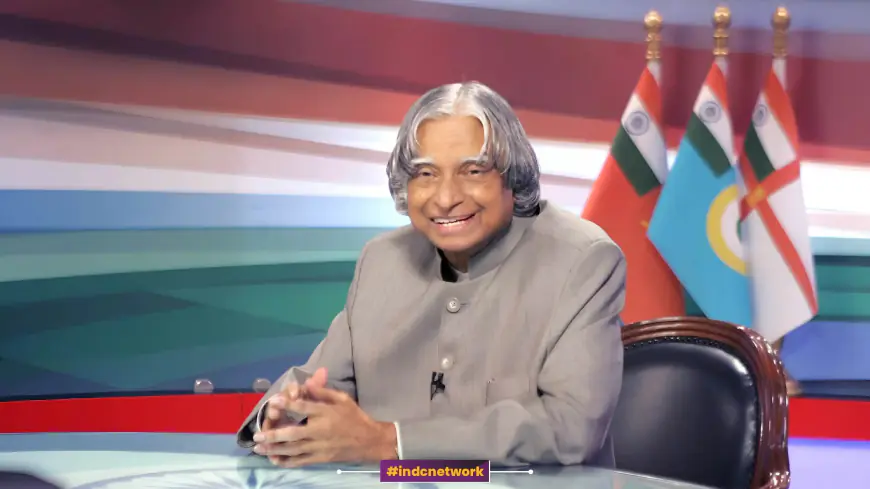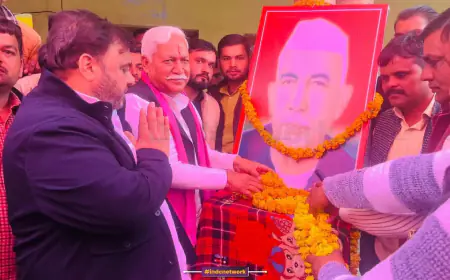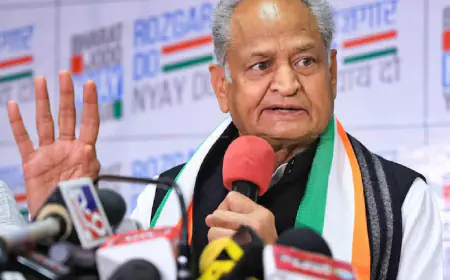Biography of A.P.J. Abdul Kalam : The Inspiring Life Journey of India's Missile Man
A.P.J. Abdul Kalam, India’s Missile Man and the 11th President, left an unforgettable legacy as a scientist, educator, and visionary leader. His humble beginnings, pioneering work in space and missile technology, role in Pokhran-II nuclear tests, and inspiring tenure as the People’s President continue to motivate millions. This article explores his remarkable life story, contributions to India, and enduring legacy.

INDC Network : Biography : A.P.J. Abdul Kalam: The People's President and the Missile Man of India
Dr. Avul Pakir Jainulabdeen Abdul Kalam, fondly known as A.P.J. Abdul Kalam, was one of India’s most distinguished scientists, educators, and statesmen. His life journey is a testament to the power of perseverance, dedication, and humility. From his humble beginnings in a small village in Tamil Nadu to becoming India’s 11th President, Kalam left an indelible mark on the nation. His legacy continues to inspire millions of young people to dream, aspire, and contribute to the progress of humanity.
Early Life and Education : A.P.J. Abdul Kalam was born on October 15, 1931, in Rameswaram, a small town on Pamban Island in Tamil Nadu, India. His father, Jainulabdeen Marakayar, was a boat owner and imam at a local mosque, while his mother, Ashiamma, was a homemaker. Though the family was not wealthy, they were deeply committed to education and spirituality.
From an early age, Kalam showed an insatiable curiosity about the world around him. His fascination with flight and the sky began when he saw birds gliding effortlessly above. Despite financial constraints, his parents supported his education. He attended the local school in Rameswaram and later moved to Schwartz Higher Secondary School in Ramanathapuram. His academic journey was marked by hard work, discipline, and a profound interest in science and mathematics.
Kalam's love for physics and mathematics led him to pursue aerospace engineering at the Madras Institute of Technology (MIT). Though MIT posed financial challenges, his elder sister sold her jewelry to support his education. At MIT, Kalam worked diligently and soon earned a reputation for his problem-solving skills and innovative thinking.
Early Career and Work in Space Research : After completing his degree in 1957, Kalam joined the Aeronautical Development Establishment of the Defense Research and Development Organization (DRDO) as a scientist. His early work involved designing small hovercrafts and improving the technology for India's defense systems. However, he felt somewhat restricted at DRDO, as his real passion lay in space exploration.
In 1969, Kalam's career took a significant turn when he was transferred to the Indian Space Research Organisation (ISRO). This move brought him closer to his dream of working on space technology. At ISRO, Kalam played a critical role in the development of the Satellite Launch Vehicle (SLV-III), which successfully deployed the Rohini satellite in near-Earth orbit in 1980. This achievement made India one of the few countries capable of indigenous satellite launch.
Kalam’s work at ISRO laid the foundation for India’s ambitious space program. Under his leadership, ISRO made significant strides in space research and development, which paved the way for future missions such as Chandrayaan and Mangalyaan.
The Missile Man of India : While his contributions to space technology were remarkable, it was his work in missile development that earned Kalam the title of "The Missile Man of India." In 1982, Kalam returned to DRDO as the Director of the Integrated Guided Missile Development Programme (IGMDP). This ambitious program aimed to make India self-reliant in missile technology and included the development of five key missile systems: Prithvi, Agni, Trishul, Akash, and Nag.
Kalam’s leadership was instrumental in the successful development of these missile systems, which significantly bolstered India’s defense capabilities. The Prithvi missile was India’s first indigenously developed ballistic missile, while the Agni series established India’s long-range nuclear capabilities. His work in this field not only brought international recognition to India but also made the nation a major player in global defense technology.
In recognition of his efforts, Kalam was awarded the Padma Bhushan in 1981, the Padma Vibhushan in 1990, and India’s highest civilian award, the Bharat Ratna, in 1997. His work on missile development not only contributed to national security but also inspired generations of Indian scientists to innovate and excel in the field of defense technology.
Pokhran II: India's Nuclear Tests : In 1998, A.P.J. Abdul Kalam played a pivotal role in India's nuclear tests at Pokhran. As the Chief Scientific Advisor to the Prime Minister and the head of the DRDO, Kalam coordinated with scientists from the Bhabha Atomic Research Centre (BARC) to carry out a series of underground nuclear tests, codenamed Operation Shakti.
The successful tests propelled India into the league of nuclear-capable nations, changing the geopolitical landscape of South Asia. These tests were carried out under intense secrecy, and Kalam’s leadership ensured the smooth execution of this highly sensitive mission. The tests also cemented his reputation as a key figure in India’s defense and strategic establishment.
Vision for India: Dreaming of a Developed Nation ; A.P.J. Abdul Kalam’s vision extended far beyond defense and technology. He was a firm believer in the potential of India as a developed nation. In his famous book, "India 2020: A Vision for the New Millennium", he laid out his dream of transforming India into a knowledge superpower. His ideas emphasized the importance of education, innovation, and rural development as the cornerstones for India’s growth.
Kalam advocated for harnessing the power of science and technology to address some of India’s most pressing problems, such as poverty, illiteracy, and environmental degradation. He believed in the empowerment of youth through education and entrepreneurship, and he constantly encouraged young people to dream big and work towards their goals with determination and hard work.
Kalam also had a deep spiritual side, often referring to ancient Indian scriptures for inspiration. He was influenced by the teachings of Swami Vivekananda, Mahatma Gandhi, and other Indian philosophers. Despite his scientific background, Kalam believed in the harmony of science and spirituality, viewing them as complementary forces that could drive societal progress.
Presidency: The People's President : In 2002, A.P.J. Abdul Kalam was elected as the 11th President of India, succeeding K.R. Narayanan. His presidency was marked by a unique blend of humility, simplicity, and dedication to public service. Known as the "People's President," Kalam connected with citizens in a way that few political figures had ever done before. He was particularly popular among young people, often engaging with students across the country and encouraging them to pursue their dreams.
During his five-year tenure, Kalam worked tirelessly to make Rashtrapati Bhavan more accessible to the public, often inviting students and ordinary citizens to visit the presidential residence. His speeches were filled with messages of hope, peace, and national development, and he used his platform to promote education, technological advancement, and social harmony.
Kalam’s tenure was not without challenges. He faced criticism for his decision to sign the Office of Profit Bill and for his role in the dissolution of the Bihar Assembly in 2005. However, his integrity, moral clarity, and commitment to the nation earned him widespread respect across the political spectrum.
Life After Presidency: A Mentor to the Youth : After his term as President ended in 2007, Kalam continued to be a guiding force in the lives of millions. He returned to what he loved most: teaching and interacting with young minds. He became a visiting professor at several prestigious institutions, including the Indian Institute of Technology (IIT) and the Indian Institute of Science (IISc). He delivered lectures and wrote extensively, spreading his vision of a developed India and the role of youth in shaping the future.
Kalam authored numerous books during his lifetime, with some of the most popular being "Wings of Fire," "Ignited Minds," and "My Journey." These books provided insights into his personal experiences, dreams for the nation, and motivational messages for the youth.
Final Moments and Legacy : On July 27, 2015, while delivering a lecture at the Indian Institute of Management Shillong, A.P.J. Abdul Kalam collapsed due to cardiac arrest. He passed away doing what he loved most: interacting with students and sharing his knowledge.
Kalam’s death was mourned by millions across India and the world. His funeral was attended by political leaders, scientists, students, and common citizens who admired and respected his life’s work. Despite his departure, Kalam’s legacy lives on through the institutions he helped build, the technologies he helped develop, and the countless lives he touched through his work and words.
Conclusion: An Eternal Inspiration : A.P.J. Abdul Kalam was more than a scientist, a missile man, or a president; he was an embodiment of India's potential and its aspirations. His journey from a small town in Tamil Nadu to becoming one of the nation’s most beloved leaders is a story of resilience, hard work, and unyielding faith in the power of education and innovation.
Kalam's life continues to inspire millions, particularly the youth, to pursue their dreams with passion, dedication, and a sense of responsibility towards society. His vision of a developed India, driven by knowledge and technological progress, remains a guiding light for the nation. Dr. A.P.J. Abdul Kalam will always be remembered as a true national hero and a symbol of hope, wisdom, and inspiration for generations to come.
What's Your Reaction?














































































































































































